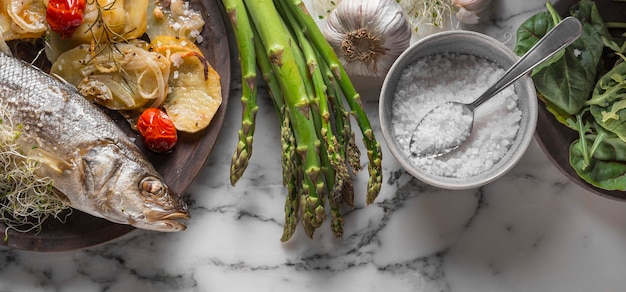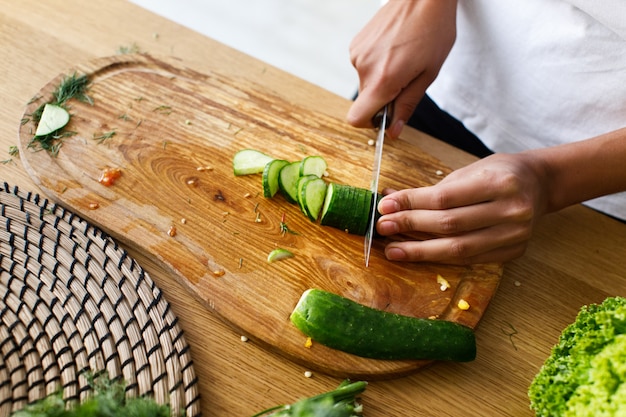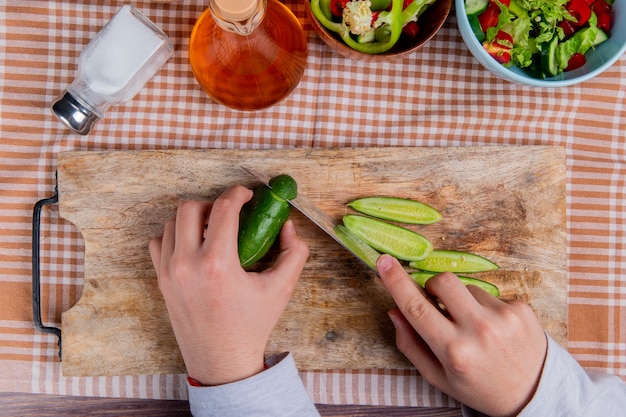Asparagus – the harbinger of spring, a symbol of fresh beginnings, and a culinary delight! Every year, I eagerly await the arrival of those vibrant green spears, their delicate flavour and unique texture bringing joy to my taste buds. But for many, asparagus can seem a bit intimidating, a vegetable shrouded in mystery. Fear not, my fellow food enthusiasts! This comprehensive guide will demystify asparagus, taking you from the market to your plate with confidence and culinary prowess.
(Part 1) A Stroll Through the Market: Selecting and Storing Asparagus

Asparagus Shopping 101: Choosing the Right Spears
First, we venture into the heart of the market, where the bounty of spring awaits. When selecting your asparagus, remember, it's all about finding the perfect specimen – one that whispers tales of freshness and flavour. Here's what to look for:
- Tightly closed tips: These are the hallmark of young, tender asparagus. Open or floppy tips are a sign of age, and the spears might be losing their delicate flavour.
- Vibrant green colour: A dull or yellowing colour suggests that the asparagus is past its prime.
- Medium-sized spears: These offer a delightful balance of flavour and texture. While thin spears might be tender, they can be a bit bland. Thick spears can be tough and woody.
- No blemishes or damage: Look for spears that are free from any cuts, bruises, or other signs of damage.
Keeping Asparagus Fresh: Storing Your Bountiful Harvest
You've found the perfect bunch – now it's time to bring it home and ensure it stays fresh and vibrant. Follow these steps for optimal storage:
- Trim the ends: A crucial step in preserving asparagus's moisture. Snip off about half an inch from the bottom of each spear.
- Wrap it up: Wrap the asparagus loosely in a damp paper towel or a clean kitchen cloth, to maintain moisture.
- Refrigerate it: Place the wrapped asparagus in the crisper drawer of your refrigerator, ideally not in direct contact with other fruits or vegetables.
- Freeze it for later: For longer storage, blanch the asparagus first by boiling it for 2-3 minutes, then plunge it into ice water to stop the cooking process. Once drained, you can freeze the blanched spears in airtight bags or containers.
(Part 2) Preparing for Culinary Glory: Washing and Trimming

Washing Away the Market Dust
Now, it's time to prepare the asparagus for cooking. Start by giving them a thorough wash to remove any lingering dirt or debris:
- Rinse under cold water: Hold the asparagus under a gentle stream of cold water, ensuring every spear is clean.
- Scrub it up: Use a vegetable brush to gently scrub any stubborn dirt, especially around the base of the spears.
- Pat it dry: Pat the spears dry with a clean kitchen towel before moving on to the trimming stage.
Trimming the Woody Ends
Here's where things can get a little technical, and where personal preference comes into play.
- Spot the woody bottom: Identify the tougher, fibrous bottom part of the asparagus spear – this is the portion that will be unpleasant to eat.
- The snap test: The traditional method – hold the spear at the base and gently bend it until it snaps. The breaking point usually marks the beginning of the woody part.
- Knife work: If snapping doesn't feel right, use a sharp knife to trim off the woody end.
- Tip trimming: This step is optional, but some people prefer to trim the very tips as they can be slightly tougher.
(Part 3) Unveiling the Flavour: cooking asparagus to Perfection

Asparagus is a wonderfully versatile vegetable that responds beautifully to various cooking methods. Each method brings its unique flavour and texture to the table. Here are some popular techniques to explore:
Roasting: A Sweet and Smoky Delight
Roasting is one of my personal favourites, as it intensifies asparagus's natural sweetness and adds a lovely char.
- Preheat your oven: Set your oven to 400°F (200°C) to ensure the asparagus cooks evenly.
- Toss with oil and seasonings: Drizzle the trimmed spears with olive oil, then season generously with salt and pepper. For added depth, you can sprinkle in garlic powder, onion powder, or even paprika.
- Bake in a single layer: Spread the asparagus on a baking sheet in a single layer, ensuring they're not crowded to prevent steaming instead of roasting.
- Roast until tender-crisp: Bake for 10-15 minutes, or until the asparagus is tender-crisp with a slight char on the edges.
Grilling: A Smoky Kiss of Flavour
Grilling adds a smoky dimension to asparagus, perfect for outdoor meals and warm weather gatherings.
- Preheat your grill: Heat your grill to medium heat, ensuring it's ready to cook.
- Drizzle and season: Coat the asparagus with olive oil, then season with salt and pepper.
- Grill directly on the grates: Place the spears directly on the grill grates. For extra insurance against sticking, lightly oil the grates beforehand.
- Grill to perfection: Cook for 5-7 minutes, turning them halfway through, until they're tender-crisp and lightly charred.
Sautéing: A Quick and Easy Weeknight Option
Sautéing is a quick and easy method, ideal for weeknight meals when you need a simple yet satisfying side dish.
- Heat your skillet: Heat a drizzle of olive oil in a large skillet over medium heat.
- Sauté until tender-crisp: Add the asparagus and sauté for 3-5 minutes, or until they're tender-crisp.
- Season to taste: Season with salt and pepper, and add any other seasonings you enjoy, like a squeeze of lemon juice or a sprinkle of herbs.
Boiling: A Classic Method for a Simple Asparagus Side
Boiling is a classic method that yields a tender asparagus, perfect for simple dishes or as a base for other recipes.
- Bring a pot of salted water to a boil: Fill a large pot with water, add salt, and bring it to a rolling boil.
- Boil until tender-crisp: Add the asparagus to the boiling water and cook for 2-3 minutes, or until they're tender-crisp.
- Drain immediately: Immediately drain the asparagus in a colander and serve them hot.
(Part 4) Unleashing Culinary Creativity: asparagus recipes for Every Occasion
Simple Asparagus Sides: From Basic to Brilliant
Asparagus is a fantastic side dish, adding a touch of spring and elegance to any meal. Here are two simple yet delicious recipes:
Roasted asparagus with lemon and parmesan
This classic combination is a symphony of flavours – bright lemon zest, nutty Parmesan, and the sweetness of roasted asparagus.
- Roast the asparagus: Follow the roasting instructions above.
- Prep your aromatics: While the asparagus is roasting, zest a lemon and finely chop a few sprigs of fresh parsley.
- Toss for flavour: Once the asparagus is roasted, toss it with the lemon zest, parsley, and grated Parmesan cheese.
- Season and serve: Season with salt and pepper to taste and serve hot.
Garlic Butter Asparagus
This is a quick and easy recipe that packs a punch of flavour, perfect for weeknight dinners.
- Sauté the asparagus: Sauté the asparagus according to the instructions above.
- Melt the butter: While the asparagus is cooking, melt a knob of butter in a small saucepan.
- Add the garlic: Add a few cloves of minced garlic to the melted butter and cook for a minute until fragrant.
- Pour and toss: Pour the garlic butter over the asparagus and toss to coat.
Asparagus in Salads: Fresh and Light Delights
Asparagus adds a beautiful spring flavour and texture to salads, making them both refreshing and satisfying.
Spring Asparagus and Strawberry Salad
This salad is a celebration of spring flavours – sweet strawberries, tangy goat cheese, and tender asparagus.
- Mix the greens: Combine a mix of spring greens, such as baby spinach, arugula, and frisée.
- Add the ingredients: Add sliced strawberries, roasted asparagus, and crumbled goat cheese.
- Toss with vinaigrette: Toss the salad with a simple vinaigrette made with olive oil, balsamic vinegar, salt, and pepper.
grilled asparagus and quinoa salad
This hearty salad is a complete meal, packed with protein and nutrients from quinoa, grilled asparagus, and feta cheese.
- Cook the quinoa: cook quinoa according to package directions.
- Grill the asparagus: Grill the asparagus according to the instructions above.
- Combine the ingredients: Combine the cooked quinoa, grilled asparagus, cherry tomatoes, red onion, and crumbled feta cheese.
- Dress and sprinkle: Drizzle with a lemon vinaigrette and sprinkle with chopped fresh dill.
Asparagus Mains: Elevated Asparagus Dishes
Let's move on to some asparagus-centric main courses that showcase this versatile vegetable in a whole new light.
Creamy asparagus pasta
This comforting pasta dish is both delicious and easy to make.
- Cook the pasta: Cook your favourite pasta according to package directions.
- Sauté the asparagus: While the pasta is cooking, sauté the asparagus according to the instructions above.
- Make the cream sauce: In a separate pan, melt a knob of butter and whisk in heavy cream. Season with salt, pepper, and nutmeg.
- Combine and garnish: Add the cooked asparagus and pasta to the cream sauce and toss to combine. Garnish with grated Parmesan cheese and fresh basil.
Asparagus Quiche
This classic French quiche is perfect for brunch, a light dinner, or a delightful potluck contribution.
- Preheat your oven: Preheat your oven to 375°F (190°C).
- Prepare the pie crust: Prepare a pie crust, either from scratch or using a store-bought one.
- Sauté the asparagus: Sauté the asparagus according to the instructions above.
- Whisk the egg mixture: In a bowl, whisk together eggs, milk, cream, salt, pepper, and nutmeg.
- Pour and top: Pour the egg mixture into the pie crust. Top with the sautéed asparagus, shredded cheese, and diced bacon or ham.
- Bake until set: Bake for 30-40 minutes, or until the centre is set.
Asparagus Tart
Similar to a quiche, but with a flakier crust, this tart is a beautiful and delicious way to showcase asparagus.
- Preheat your oven: Preheat your oven to 375°F (190°C).
- Prepare the tart crust: Prepare a tart crust, either from scratch or using a store-bought one.
- Blanch the asparagus: Blanch the asparagus by boiling it for 1-2 minutes, then shock it in ice water to stop the cooking process.
- Combine the filling: In a bowl, combine ricotta cheese, grated Parmesan cheese, eggs, salt, pepper, and nutmeg.
- Spread and arrange: Spread the ricotta mixture over the tart crust. Arrange the blanched asparagus spears on top of the ricotta mixture.
- Bake until set: Bake for 25-30 minutes, or until the tart is set.
(Part 5) Asparagus FAQs: Answering Your Burning Questions
1. Can you eat asparagus raw?
Yes! Raw asparagus is often used in salads and as a garnish. It has a slightly bitter flavour and a crisp texture.
2. Is asparagus good for you?
Absolutely! Asparagus is a powerhouse of nutrients, boasting vitamin K, folate, vitamin C, and fiber. It's also a good source of antioxidants, contributing to overall well-being.
3. How can I tell if asparagus is bad?
Look for signs of wilting, yellowing, or soft tips. The spears should be firm and have a fresh, vibrant green colour. If the asparagus smells bad or has a slimy texture, it's definitely past its prime.
4. What does asparagus smell like after you eat it?
That's a common phenomenon! It's caused by a chemical compound called asparagusic acid, which is broken down into sulfur-containing compounds when it's digested. Some people are more sensitive to this compound and experience a stronger smell in their urine after eating asparagus.
5. What other vegetables are similar to asparagus?
Several vegetables share similarities in texture and flavour with asparagus, offering delicious alternatives:
- green beans: These are a great substitute for asparagus, especially in stir-fries and salads.
- Broccoli: Similar to asparagus in its nutritional profile, broccoli has a slightly stronger flavour.
- Cauliflower: A versatile vegetable that can be roasted, grilled, or steamed, cauliflower is a good option for those who want a milder flavour than asparagus.
(Part 6) Beyond the Plate: Expanding Your Asparagus Horizons
Asparagus is not confined to traditional dinner plates – it can be a star ingredient in a range of culinary creations.
Asparagus for Breakfast
Start your day with a burst of asparagus flavour:
- scrambled eggs or Omelettes: Add sautéed asparagus for a protein-packed and flavorful breakfast.
- Breakfast Hash: Sauté asparagus with pancetta or bacon for a savory and hearty breakfast hash.
- Brunch Delight: Grilled asparagus pairs beautifully with poached eggs, making for a brunch-worthy meal.
Asparagus in Smoothies
Sneak in some healthy greens with a touch of asparagus in your smoothies:
- Hidden Veggie Boost: Add a handful of blanched asparagus to your favourite smoothie recipe for a hidden dose of nutrients.
- Green Power: Pair asparagus with other green ingredients like spinach, kale, or cucumber for a vibrant flavour combination.
Asparagus Preservation
Enjoy asparagus year-round with these preservation methods:
- Freezing: Blanch the asparagus first, then freeze it in airtight bags or containers.
- Pickling: Pickled asparagus is a tangy and delicious treat.
- Drying: Dried asparagus can be used in soups, stews, or as a snack.
(Part 7) Asparagus Trivia and Fun Facts: A Little asparagus history
Discover some fascinating facts about this beloved spring vegetable:
- Lily Family: Asparagus is a member of the lily family, a connection that might surprise some!
- Greek Roots: The word "asparagus" comes from the Greek word "asparagos," which means "sprout."
- Ancient Egyptian Origins: The earliest known asparagus cultivation dates back to ancient Egypt, where it was prized for its flavour and medicinal properties.
- Fiber Powerhouse: Asparagus is a good source of fiber, which can help with digestion and promote gut health.
- Natural Diuretic: Asparagus acts as a natural diuretic, increasing urine production, which can be beneficial for overall hydration.
- Variable Asparagusic Acid: The amount of asparagusic acid, the compound responsible for the distinct smell in urine after eating asparagus, varies between individuals. Some people have a strong reaction, while others experience no noticeable effect.
(Part 8) Asparagus: A Celebration of Spring
From the bustling market to your kitchen table, asparagus is a testament to the delights of spring. I hope this comprehensive guide has equipped you with the knowledge and confidence to embrace this versatile vegetable. So go forth and experiment, create culinary masterpieces, and enjoy the unique flavour and texture that asparagus brings to your table! Happy cooking!
Everyone is watching

How to Cook Frozen Lobster Tails Perfectly: A Step-by-Step Guide
RecipesLobster. Just the word conjures up images of lavish meals, special occasions, and a taste of luxury. But let's...

Pigs in a Blanket Cooking Time: How Long to Bake for Perfect Results
RecipesAh, pigs in a blanket. Just the name conjures up images of those delightful little parcels of crispy pastry en...

Pork Fillet Cooking Time: How Long to Cook It Perfectly
RecipesPork fillet, or tenderloin as it's sometimes called, is a real favourite in our house. It's so versatile, and...

The Ultimate Guide to Tender, Juicy Pulled Pork
RecipesRight, let's talk pulled pork. It's one of those dishes that just screams "comfort food," doesn't it? I mean...

The Ultimate Guide to Cooking Delicious Frankfurters
RecipesLet's face it, we all love a good frankfurter. It's a classic, simple, and always satisfying. But let's be rea...
